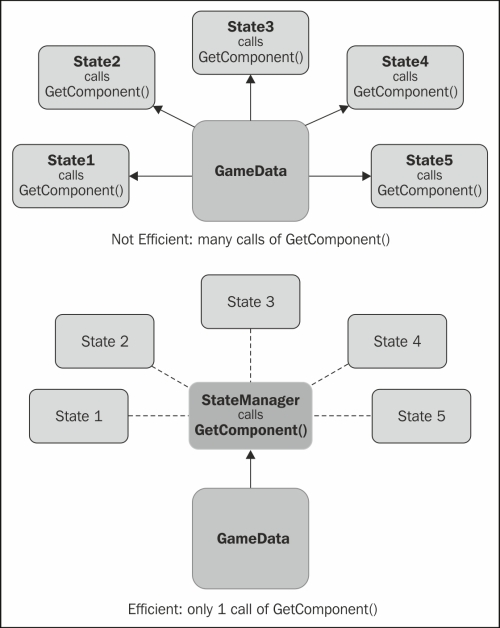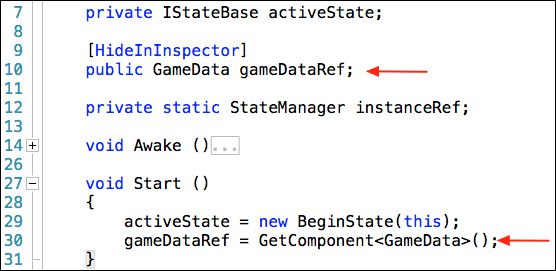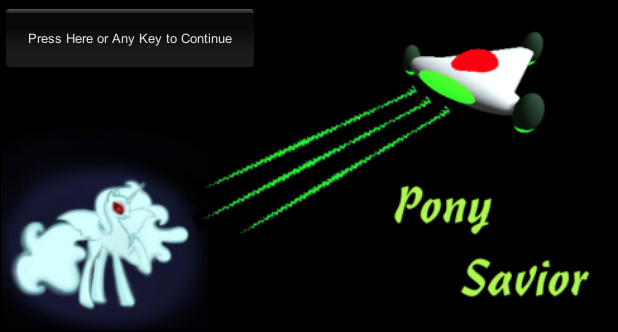We could create a regular C# class for this, but we want to be able to assign some values in Unity's Inspector, so we'll create a Unity C# Script instead. There are times when you will want to use the Inspector, and other times, when assigning values in code is better.
To start, we are going to create three variables to store the images used for the three splash screens in BeginState, WonStates, and LostStates.
- In the
Scriptsfolder, create a new C# Script namedGameData, containing the following code:using UnityEngine; using System.Collections; public class GameData : MonoBehaviour { public Texture2D beginStateSplash; public Texture2D lostStateSplash; public Texture2D wonStateSplash; void Start () { } void Update () { } } - Attach this
GameDatascript to the GameManager to make it a Component. All the data in all the variables will also persist through Scene changes.
Three variables are created to store the images for the splash screens. The variables store values of type Texture2D.
You have to understand that Unity treats images as textures. Have a look at Unity Manual | User Guide | Asset Import and Creation | Importing Assets. Here's a quote:
Textures
Unity supports all image formats. Even when working with layered Photoshop files, they are imported without disturbing the Photoshop format. This allows you to work with a single texture file for a very care-free and streamlined experience.
In the Unity Manual, there's a description on how to make a splash screen. Look in Unity Manual | FAQ | Graphics Questions | How do I make a Splash Screen?
However, there is an easier way by using the GUI system. Since an image is a texture, we'll just display our images using the GUI.DrawTexture() method. This draws a texture in a rectangle. We will simply make the rectangle fullscreen.
In the previous code, the three variables will each store a Texture2D, an image. The images are assigned to these variables by dragging the images into the Inspector.

The first thing to do is import the three images you have. If you don't have anything specific already, pictures of friends or family will do nicely.
Once you have them imported, just drag them to the three variable properties in the Inspector. We have these texture images for our splash screens in the GameData Component, how do we get them to be displayed in the States we desire? By using Dot Syntax, of course. We could have each State that needs to display a splash screen, call GetComponent() to get the GameData Component.
That wouldn't be too bad with just five States needing splash screens. However, the GameData Component is for storing many types of data, not just splash screen images. This means that GameData will be accessed often for data, and calling GetComponent() repeatedly will slow down a game.
There is a more efficient way. Just call GetComponent() one time and store the GameData object reference that's retrieved into a variable. In fact, this is exactly what Unity suggests you do. Here's a quote from Scripting Reference | Overview: Performance Optimization:
3. Cache component lookups
Another optimization is caching of components. This optimization unfortunately requires a bit of coding effort and is not always worth it. But if your script is really used a lot and you need to get the last bit of performance out of it, this can be a very good optimization.
Whenever you access a component through GetComponent or an accessor variable, Unity has to find the right component from the game object. This time can easily be saved by caching a reference to the component in a private variable.

Since every State already contains a reference to StateManager, we will have StateManager call GetComponent() and store the GameData reference in a variable named gameDataRef. Let us have a look a the code in the following screenshot:

An analysis of the preceding code screenshot is given below:
In StateManager:
Line 10: public GameData gameDataRef;
- The
gameDataRefobject reference stores a reference to aGameDataComponent object - Therefore the type is
GameData - It is also
publicsince other classes will be accessing this variable
Line 30: gameDataRef = GetComponent<GameData>();
- In the
Start()method, we callGetComponent()to get a reference to theGameDataComponent object - The reference is assigned to the
gameDataRefvariable
Line 9: [HideInInspector]
- This is a Unity attribute that will prevent a
publicvariable from showing in the Inspector - Since we want the
gameDataRefvariable to only store a reference toGameData, there's no reason to allow it to be changed in the Inspector, soHideInInspectorprevents the variable from showing
Here's the code in BeginState that gets the Texture2D image from GameData, then displays it on screen. It's just one line of code. I have it on three lines to fit the page:

In BeginState:
Line 19: Code removed.
Line 23: The GUI.DrawTexture method.
- The
GUI.DrawTexture()method draws aTexture2Din a rectangle that is the size of the game screen - The
manager.gameDataRef.beginStateSplashstatement is the Dot Syntax used to retrieve the image stored in theGameDataComponent - The
managerobject reference stores a reference to theStateManagerComponent - The
gameDataRefvariable inStateManagerstores the reference to theGameDataComponent - The
beginStateSplashvariable inGameDatastores theTexture2Dimage - This is a direct retrieval of the image since there was no need to call
GetComponent()
Line 27: The if statement.
- This
ifstatement is checking if a GUI button is clicked or if any keyboard key is pressed - If either one happens, then
SwitchState()is called to switch toSetupState
Here is the result when you click on Play, a fullscreen splash screen with a GUI button:

For our little game demonstration, the BeginState code is complete. There's not much to it, a little State Machine code, one line of code to display the splash screen, and a line of code to detect when to switch to SetupState.
The following code is the complete code of BeginState:
using UnityEngine;
using Assets.Code.Interfaces;
namespace Assets.Code.States
{
public class BeginState : IStateBase
{
private StateManager manager;
public BeginState (StateManager managerRef)
{
manager = managerRef;
if(Application.loadedLevelName != "Scene0")
Application.LoadLevel("Scene0");
}
public void StateUpdate ()
{
}
public void ShowIt ()
{
GUI.DrawTexture(new Rect(0, 0,
Screen.width, Screen.height),
manager.gameDataRef.beginStateSplash,
ScaleMode.StretchToFill);
if (GUI.Button(new Rect(10, 10, 250, 60),
"Press Here or Any Key to Continue") ||
Input.anyKeyDown)
{
manager.SwitchState (new SetupState (manager));
}
}
}
}